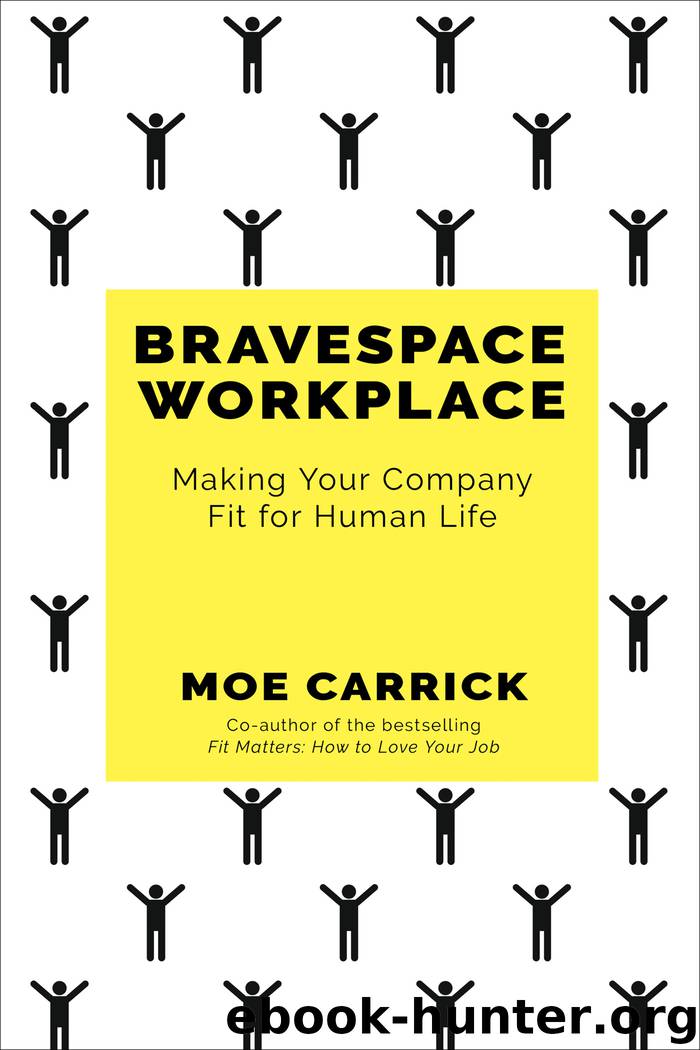Bravespace Workplace by Moe Carrick

Author:Moe Carrick
Language: eng
Format: epub
Publisher: Maven House
Published: 2019-03-09T16:00:00+00:00
“
Heart-based leaders acknowledge that emotions are important for what we do at work; they’re not a private excess that we need to hide.
“
Leaders who go first with emotional honesty and transparency potently model their own essential humanity, paving the way for others to follow.
Act II:
Teams Who Care
THE WORST TEAM I WAS EVER ON just didn’t get me. They hired me, and I was thrilled. It was a cutting-edge technology company, and I was eager to show them my stuff. What I experienced when I got there was demoralizing. There was no room for my strengths and weaknesses; I felt that all I had were weaknesses. What made it even worse was that my peers seemed to be experiencing success after success. Our meetings were a game of one-upmanship. My colleagues’ projects were all completed on time and on budget, while mine, which weren’t going as well, became the focus of every meeting. “How can you do better, Moe?” It wasn’t long before my optimism and energy had eroded to frustration and anxiety. I changed from eager and curious to fearful and secluded, merely following a to-do list, my creative spark gone. It didn’t take long for me to search out and happily commit to another firm. Back then I didn’t know what made teams click, so I assumed that I was the problem.
TEARS AT WORK
In Bravespace workplaces people use heart and head, self-awareness is encouraged, mistakes are regarded as lessons, and emotions can run high.
People often tell me that they worry that tears at work will make them appear weak, and that when someone cries in their presence, they don’t know what to do to help. Tears make us uncomfortable in different ways. Women are afraid that they’ll be regarded as overly emotional if they cry, while men who cry are often either teased or celebrated for their vulnerability.
We often assume that crying equates to sadness, but, says Ad Vingerhoets, a psychologist at Tilburg University, tears are often correlated to feelings of “helplessness, hopelessness, and the lack of adequate behavioral responses to a problem situation.” Something stressful happens, or we feel humiliated, and the tears come. As human beings, we have a limited range of ways to express intensity of feeling, and crying is one of them.
Tears are a data point. When someone is crying, it indicates that something important is going on inside of their emotional realm. Noticing this, and working to sort through the complexity of feelings, usually leads to progress in a conversation or situation. Viewing tears as important information, rather than as a shameful occurrence, helps us to normalize and utilize the gift of feeling.
Tears at work, as in the rest of life, are an act of vulnerability. When we tear up or cry at work, we’re showing up and being real. So, if someone cries at work, it’s an invitation for connection, because that person is showing the vulnerability of authentic presence. Crying is an effective way for some people to move through emotions. We will stop crying.
Download
This site does not store any files on its server. We only index and link to content provided by other sites. Please contact the content providers to delete copyright contents if any and email us, we'll remove relevant links or contents immediately.
Hit Refresh by Satya Nadella(9038)
The Compound Effect by Darren Hardy(8808)
Change Your Questions, Change Your Life by Marilee Adams(7635)
Nudge - Improving Decisions about Health, Wealth, and Happiness by Thaler Sunstein(7615)
The Black Swan by Nassim Nicholas Taleb(7010)
Deep Work by Cal Newport(6879)
Daring Greatly by Brene Brown(6445)
Rich Dad Poor Dad by Robert T. Kiyosaki(6401)
Principles: Life and Work by Ray Dalio(6210)
Man-made Catastrophes and Risk Information Concealment by Dmitry Chernov & Didier Sornette(5921)
Playing to Win_ How Strategy Really Works by A.G. Lafley & Roger L. Martin(5919)
Digital Minimalism by Cal Newport;(5664)
Big Magic: Creative Living Beyond Fear by Elizabeth Gilbert(5610)
The Myth of the Strong Leader by Archie Brown(5425)
The Slight Edge by Jeff Olson(5346)
Discipline Equals Freedom by Jocko Willink(5285)
The Motivation Myth by Jeff Haden(5156)
Stone's Rules by Roger Stone(5026)
The Laws of Human Nature by Robert Greene(4998)
